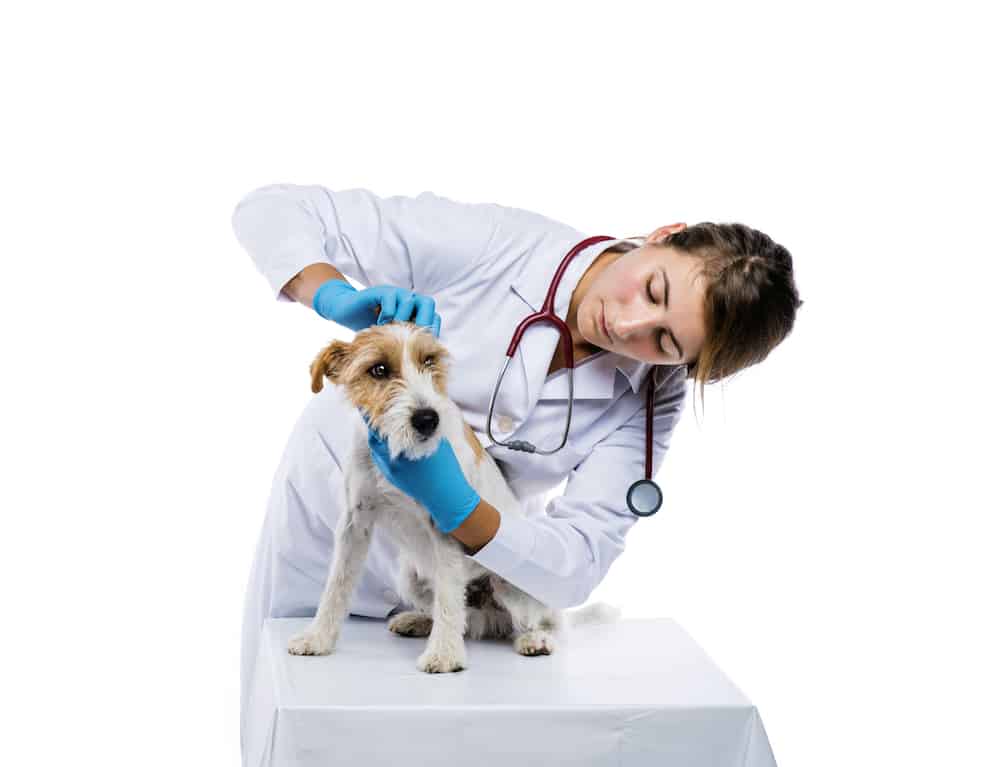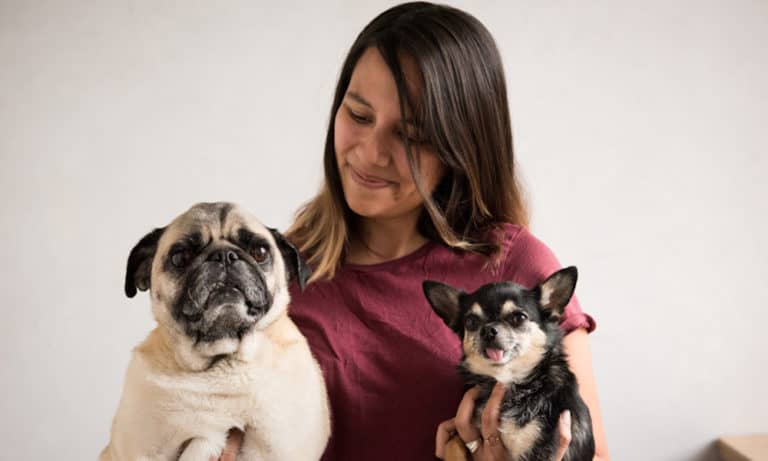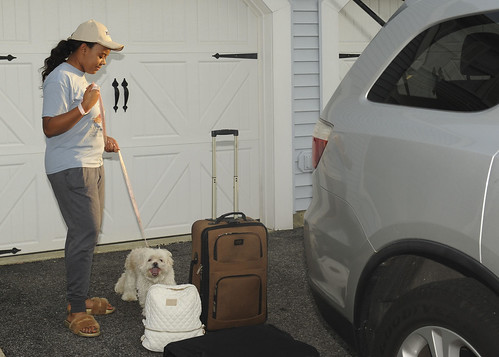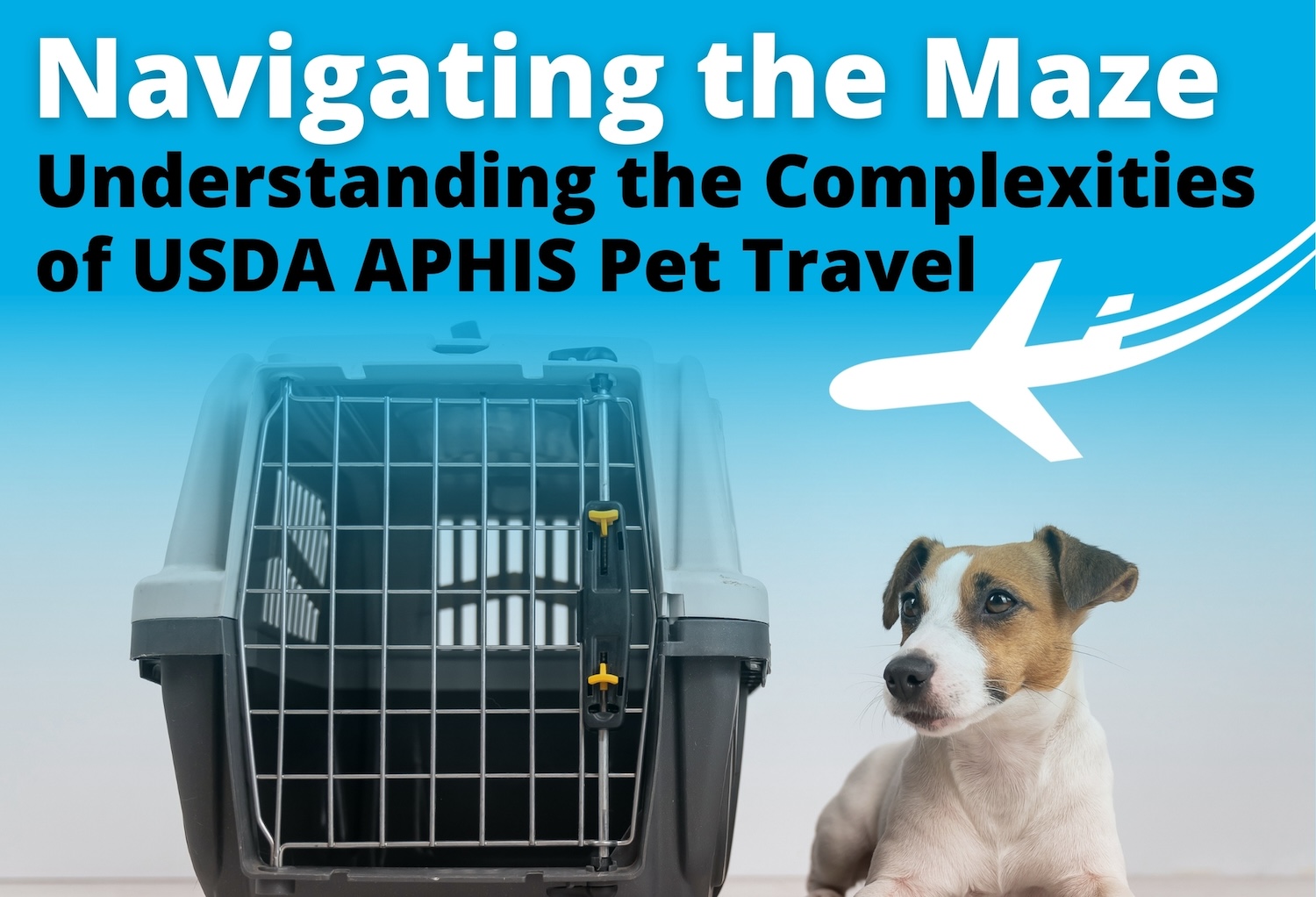

The APHIS Vet Health Certificate (Form 7001) for International Pet Transport
How to obtain and complete the aphis 7001 for pet shipping.
If you're moving internationally with your pet from the United States, you will most likely need an International Health Certificate, also known as the USDA APHIS Form 7001. We are often asked about this form, and it's one of the most searched-for documents for people planning to transport their pets to another country.
Click to download the APHIS Vet Health Certificate (Form 7001) . USDA-accredited veterinarians issue the 7001 and often must be endorsed by the corresponding state's USDA Veterinary Services office. The state and regional Veterinary Services offices oversee all export documents for pets departing from the US and ensure that the veterinarians issuing the documents, including the 7001, are accredited and filling out accurate information.
Here are the steps for obtaining the Form 7001 health certificate and having it endorsed:
1. Find a USDA-Accredited veterinarian in your area.
The USDA Veterinary Services offices do not need to see pets to issue health certificates -- they only look at the paperwork after it has been completed. You'll need to ask your local vet if they are accredited. Most vets know offhand whether or not they have this accreditation. Still, if there is any uncertainty, the nearest USDA Veterinary Services office can double-check accreditation statuses for you and your vet.
2. Download the APHIS Vet Health Certificate (Form 7001) .
3. Go to your veterinarian to get the health certificate issued.
This must be done within a specific time before your travel date -- check the pet import requirements for the country to which you're moving as well as the requirements of the airline you are flying with to determine when you will need to have the health certificate issued. Also, we highly recommend having your vet sign the form in blue ink to easily show the USDA and the destination country's government that it is an original document.
4. Check your (vet's) work!
We cannot stress this enough. As part of our service, we review our clients' paperwork carefully before sending it to the USDA for endorsement. If you arrange your pet's move independently, double (and triple!) check your veterinarian's work. If you don't, the USDA will return the documents to you unendorsed. You don't want this to happen because your pet can't depart on time!
Please make sure all dates are written correctly (we recommend formatting to DD MM YYYY to be precise); microchip numbers match up to microchip paperwork; your pet's age on the 7001 matches what's on their vaccination records (you wouldn't believe how often this is incorrect!), etc.
If you must correct the paperwork, have your vet draw a single line through the error and initial somewhere next to the correction. When in doubt, or if your health certificate becomes too messy or illegible, start with a new one.
5. Send your paperwork to the USDA (or take it in by hand).
Depending on where the nearest veterinary service office is, you can either go to the office in person to obtain the endorsement or send it in via FedEx. If you take your documents in, you will want to call at least one week in advance to ensure they will allow you to come in and make an appointment. If you send your paperwork in, you must account for a few days for the package to travel there and back (keep in mind the USDA is closed on the weekends) and include some payment information. The USDA does not take checks.
You might consider including a cover sheet with your contact information instructing them to call for a credit card number. Also, remember that if you do not include a return envelope, the USDA will send it back via US Postal Service. If you need your paperwork returned sooner (which most people do), include a pre-addressed FedEx overnight envelope with your paperwork. The USDA typically stamps documents on the same day or the following day after they receive them.
Electronic submission of APHIS Form 7001 and related documents:
To streamline the pet shipping process and reduce paperwork, the USDA APHIS now offers the option to electronically submit the APHIS Form 7001 and other required documents through their online Veterinary Export Health Certification System (VEHCS). To use this service, follow these steps:
- Visit the USDA APHIS VEHCS website and create an account.
- Fill out the necessary forms, including the APHIS Form 7001, electronically within the system.
- Upload any additional required documentation, such as vaccination records and microchip information.
- Submit the completed forms and documents for review and endorsement by the appropriate USDA office.
- Once endorsed, you will receive a notification to download and print the endorsed documents for use during your pet's travel.
The VEHCS system can save time and reduce the risk of lost or delayed paperwork, ensuring a smoother pet shipping experience.
- United States
- Restaurants & Bars
- Dog Beaches in the U.S. | Dog Friendly Beaches
- Dog Beaches — Canada
- Pet Friendly Campgrounds and RV Parks U.S.
- Pet-Friendly Campgrounds — Canada
- Pets in U.S. National Parks & Forests
- Pet Friendly State Parks and Forests U.S.
- Dog Parks — United States
- Dog Parks — Canada
- Pet-Friendly Shopping Malls
- Pet-Friendly Activities & Attractions
- Private Jet Charters
- Pet-Friendly Airports — United States
- Animal and Pet Relief Areas at Airports in Canada
- International Pet Travel
- Train Travel
- R.V. Travel
- Boat Travel
- Pet Travel Tips
- Pet Evacuation & Emergency Shelters
- Pet Friendly Timeshares and Timeshare Resorts
- Hotel Chains Pet Policies
- Travel with Pet Birds
- Pet Adoption / Animal Rescue
- Purchasing a Pet Online
- Pet Travel Products
- Pet Friendly Travel in the News
- Friends of PetFriendlyTravel.com
- List Your Property on PetFriendlyTravel.com
- Property Listing FAQs
- Testimonials
- Customer Log In / Register
Cart is empty

Brazil Pet Import/Export Requirements
Brazil pet import/export requirements are as follows: Pet dogs and cats may enter Brazil only upon presentation of an International animal health certificate (APHIS 7001 in the U.S.), issued in the area of origin of the animal. The traveler must also present a certificate of rabies vaccination. An Import Permit from Brazil is not necessary for dogs and cats, but is required for pet birds and any other pets other than dogs and cats. The International Veterinary Certificate/Pet Passport is valid for 60 days from the date of issuance, as long as the rabies vaccination stills valid. A pet microchip is not required to enter Brazil. Animals can return to Brazil with the Brazilian Pet Passport only if the requirements above are fulfilled and signed by an official veterinarian from the Ministry of Agriculture, Livestock and Food Supply. Airlines may have separate and additional requirements. Check with your airline to determine what requirements they may have, if any. More information on Brazil pet import/export requirements
Pet Friendly Travel, LLC
More information.
- Privacy Policy
- Terms of Service

Flying to Brazil with Dogs: A Step by Step Guide
Brazil is the land of samba, caipirinhas, and sandy beaches. It’s a country exploding in color, culture, and heat. We spent six weeks in Brazil with our two pups and can’t wait to return. Besides being an amazing destination for human travelers, it’s also incredibly dog friendly.
Big cities, like Rio de Janeiro and São Paulo, are packed with dogs, pet stores, and groomers, and that combined with great weather and plenty of outdoor activities makes it an unbeatable destination for you and your dog.
So grab your pup, jump on a plane, and head to one of the most magical countries in the world. Here is our guide to bringing your dog to Brazil and flying in cabin. We’re sharing it step by step, so you can go too!
Update: Effective July 14, 2021, the CDC temporarily suspended (stopped) dog imports from countries classified as high-risk for rabies. Unfortunately Brazil is on the list of countries classified as high-risk for rabies. This will make things much more difficult if you’re planning to travel to/from Brazil with your dog.

Article Contents
Step 1: Country Requirements
The first step is always to check your destination country’s requirements to see if they’re doable. Be sure to start this process early, so you have enough time to get everything done without scrambling. We checked Brazil’s policy for entering the country with pets, and then double checked the information on their government website. Then, we triple checked by calling our local consulate. The internet is a great source of information, but websites aren’t always up to date, and policies can change at any time. We like to get verbal confirmation before we start the process so we’re 100% sure of things and don’t waste time. Better safe than sorry!
To enter Brazil, we would need an International health certificate, issued 10 days before departure by a licensed veterinarian and endorsed by the USDA. We would also need a valid rabies vaccination and acknowledgment of treatment against internal and external parasites 15 days prior to travel (such as Heartworm medication). That’s it!
Remember: It’s important to stay organized throughout, and to keep a record of everything you’ll need to enter the country. Make additional hard copies of all of your documents and store them in a special folder, and keep digital copies on your phone. These simple moves will save you time and energy when traveling.

Step 2: Make Travel Arrangements
Since the health certificate is contingent on departure date, we’d need a confirmed date before moving forward. Check airline policies and look up flights. Decide how your pet’s going to fly , and which method works for you. If there’s an airline you’ve flown before with your dog and liked, see if they go to Brazil. We fly American Airlines a lot with our two pups, and have only had positive experiences.
Choose a flight, purchase your ticket and call the airline; it’s important to contact the airline with your flight information, since many companies limit the number of pets allowed on board.
Next, find carrier requirements for flying in cabin. Be sure your pets bag fits requirements and will be accepted on the air craft.

Step 3: Call the Vet
Once your date is confirmed, you’ll need to call your vet. Speak to them about your travel plans, the requirements, and set up an appointment. If your dog has a valid rabies vaccine, schedule your appointment for 8 – 10 days before your departure date. If they don’t, you’ll need to get a vaccine at least 21 days before departure.
Our dogs were up to date on rabies, so we scheduled an appointment 9 days prior to leaving. Make sure to ask your vet if they can provide the international health certificate, or if you should bring a copy yourself. Done and done.
Step 4: Vet Visit

Our vet visit went great! The vet checked over our dogs, and checked off on treatment against internal and external parasites, since we give our dogs Frontline and Heartworm medicine. She filled out the health certificate, and gave us the green light on travel. All good!

Step 5: USDA Endorsement
Next, our health certificated needed to be endorsed by the USDA . That means they would need to review our documents and stamp them. We used FedEx to overnight the following:
- Rabies vaccination certificate
- PRE-PAID return label
- Pet Export Checklist
It’s important to make a copy of all documents before mailing them and to keep a record of your tracking numbers. We sent the documents on a Thursday, and they were returned to us by Saturday.
Important Things to Note:
*USDA processing times vary, and offices are closed on weekends and national holidays. Get your documents in as soon as possible.
*If you are overnighting your documents, ask the carrier about weekend deliveries. You will typically have to sign off on them.
*You can either submit your documents via mail or in person, if a USDA office or affiliate office is close enough. Find the location that governs your state and give them a call.
Step 6: Flight Day

Our flight was late at night, so we spent the day making sure the dogs got plenty of exercise so they’d be nice and sleepy for the flight. We gave them a small dinner four hours before the flight, and headed to the airport early. Give yourself plenty of time at the airport to check in and go through security. The gate agent reviewed our documents and carrier, and we were good to go.
Step 7: Arrival Check

When we landed, we went through immigration, grabbed our bags, and were motioned towards an area to get checked by a health inspector. A Brazilian officer looked over both dogs, checked our documents and made copies of them. She filled out some entry forms and gave us copies before sending us on our way.
Welcome to Brazil!
Have you ever flown to Brazil with your dog? We’d love to hear about it.
Learn more about dog-friendly brazil here . .
Pin for later!

Similar Posts

The Ultimate Guide to Hiking Dois Irmãos
A hike in Zona Sul gets you to the best views Rio de Janeiro has to offer. Here is everything you need to know about hiking Dois Irmãos.

Pet Bloggers Journey 2023
My Pet Bloggers Journey for 2023! Learn what major changes happened in 2022 and how I’ll be tackling this upcoming year.

In the Dog House: What to do During Quarantine
Staying indoors with your dog isn’t so bad. Check out this list of activities to keep you busy while social distancing.

How I Learned Portuguese: Tips for Learning a New Language
Here are tips on how to learn Portuguese – or any language – so you too can enjoy being multi-lingual and build deeper connections.


12 Foods You Must Try in Rio de Janeiro, Brazil
It’s worth taking a break from the beach to stuff your face with all the tasty cuisine Rio has to offer. Here’s what food to eat in Rio de Janeiro.

Creative Dog Moms To Follow On Instagram
One of the best parts of being on Instagram is meeting other dedicated and creative dog moms, both virtually and IRL! Here are some of our favorites.
37 Comments
First of all, great post and it helped me a lot as I am looking to take my dog to Brazil with me. Second, what is the process/requirements to return to the US with the dogs? Thank you
Hi! Thanks for reading. The health certificate from the USA is valid for 60 days (2 months) from the date of issue. So, if you’re returning to the USA within 2 months of entering Brazil, you can use the same paperwork. Here’s the official statement on the health certificate:
“This international Veterinary Certificate is valid for sixty (60) days from the date of issue for entering or returning to the MERCOSUR party countries, as long as the rabies vaccination is valid.”
Enjoy Brazil. 🙂
Thanks so much for this critical information. It has been most useful. I am so glad I found your blog. We have followed your steps and are about 11 days away from our trip to Sao Paulo, Brasil. The only thing I found today that is a bit concerning, and I am not sure if this is something new, is the requirement to get back to the US. It seems the CDC requires a certificate that validates that our dog does not have or has not gotten screwworm while in Brasil. Was this something that you saw was asked for when you traveled with your dogs?
I sent an email to the USDA and they said that it is a requirement and that I did have to make arrangements in Sao Paulo to see a vet and give our dog the clearance. However, it almost make no logical sense since we will be there for only 10 days, and they requirement is to do the certification within 5 days of traveling into the US. Regardless, I replied back asking them if the certification only needed to be signed/certified by the vet and not by an official institution (such as the department of agriculture of Brasil), and if it needed to be translated and certified into English. At that point they replied saying that I needed to reach out to CDC and find out about these requirements with them.
My wife is a bit nervous about this, since we have everything else ready (have appointment with vet tomorrow to get our health cert and mail it to USDA), but this particular certification would be a hassle to get done in Brasil since we don’t know any vets there and not sure if they would even be able to accommodate us in such short notice.
Any insight about how things went when you got back state-side would be greatly appreciated; specially if they asked for any additional documentation or certificates.
Thanks a million for this awesome blog and for all the information you have provided to all of us fur-parents. 🙂
Hi Gilbert,
Thanks for reading! I’m glad you found it helpful.
I’m interested to know where you found that CDC requirement. I’ve never heard of it before. Can you send me a link? You can contact me at [email protected] .
I don’t want to give you a definitive answer (policies are always changing), but here’s what I think. If you have your vet fill out the USDA Brazil form ( found here ), you’ll see at the bottom that it’s valid for 60 days. You should be able to use this same form to re-enter the United States. I have done this myself (used this form, and gone to/from the USA to Brazil within 60 days).
Thank you so much for your reply. The CDC requirement is listed on the USDA website. Here is the link: https://www.aphis.usda.gov/aphis/pet-travel/bring-pet-into-the-united-states/pet-travel-dogs-into-us
We are in Brazil already (In Sao Paulo), and everything getting out of the US was a breeze. We had no issues whatsoever. However, when we landed here in Sao Paulo, the representative for the department of Agriculture took our International Health Certificate away and said we had to follow some instructions to submit a request for a new Health Certificate online at least 5 days prior to our travel day. So we called the department of Agriculture to find out why the International Health Certificate that we brought (which they kept at the airport) is not valid to reuse to travel back. They said that the certificate is only valid for one use and that we have to submit a requests for a new one from Brazil. The worst part is that we have to get a new health certificate from a veterinary here in Brazil which obviously makes this more difficult.
I submitted the request online with just the copy of the International Health Certificate we brought from the US, in the hopes that they approve it. If they don’t, then we would have to go see a veterinary and do all that all over again.
Just wanted to update you and your readers about our experience so far. We are truly thankful for your information as it helped us get everything in order to travel out of the US. Now we are crossing our fingers that we don’t have to re-do this process all over in Brazil.
Hope this helps… I will keep you posted on how everything ends up.
Thank you for the follow up! How stressful, I hope you are given the new Health Certificate online so you don’t have to visit a vet. Glad you have copies of everything, and that leaving the US was smooth! I have never heard that health certificates can only be used once (I have used many for entering and exiting).
Interested to hear about what happens, please keep us updated! Best of luck.
I am planning my trip to visit Brazil in December. I found you comments super helpful because I would not know about this if it weren’t for you. Were you able to get a new International Health Certificate without repeating the entire process in Brazil? How did everything go?
Hopefully, you were able to come back to the US smoothly with your dog and enjoyed your trip!
Hello Kennia,
I am so sorry it took so long to respond. I hope I am not too late since you said you were traveling in December. Here is the short of it, and then I will go into more detail after for those who like reading longer, more detailed posts:
We DID have to go to the Vet in Brazil. I am not sure if this is new, or if it is specific to Sao Paulo, but no matter what we did, and how many times we contacted the department of agriculture at the airport, they told us that without an international health certificate from Brazil, our dog was not going to be able to board the plane. So, we ended up going to my mother-in-law’s dog’s vet, who was very nice and helped us by providing not only the International Health Cert, but did a full check on our dog (included on the cost) and gave her a clean bill of health in writing so we can add it to our documentation. Luckily we had all the copies of all the documents we used for the one we got in the US, because that had the names of the vaccines they gave our dog and the vet in Brazil was able to enter that information in the new health cert.
As you can imagine, other than the LaTam representative at the check-in desk took a quick look at the paperwork (didn’t really read it, just skimmed through it I guess looking for dates and signatures), and then handed it back to us. NO ONE ELSE asked for the darn paper until we got into the US. Funny enough, I asked the gentleman that checked the paperwork if the original Health Cert we received in the US would have sufficed, and he said “as long as it is within those 60 days, then you are fine. However, he did mention that lately, people coming from Brazil have been bringing the new one filled out by a Brazilian vet. Hopefully this is helpful to you, Kennia.
This change in our plans was very frustrating due to the fact that we had to pay more money, make appointments, travel to the vet, spend time at the vet (literally almost 4 hours), for a piece of paper that no one in Brazil cared to verify, and specially after finding out from the US customs agents that we could have used the original one to re-enter. However, this is not the US jurisdiction. Brazil, as a sovereign country has the right to change its policies and do as they please. They are actually proud of the fact that they are not allowing dogs travel out of Brazil with any illnesses or parasites (which I guess is a good thing). In the end, my wife and I just wanted to make sure that our dog returned home with us, so we did whatever it took, and it really only took half a day of our travel plans to take care of this. The online form is easy to fill out and quick, but you do need a Brazilian’s CPF (which is kind of like their State ID/Tax ID) in order to fill out the form. If you don’t know anyone in Brazil, then I suggest you do not travel with your dog. You WILL need the CPF. There is no way around it.
So, to summarize, these are the steps we took to bring our dog back from Brazil and into the US:
1) Call local vets in Brazil, or have someone you know where you are visiting to call vets that know how to fill out the International Health Certificate form (You can get the form from the website listed on the little paper they give you at the airport). 2) When you find one that knows how to do it (VERY IMPORTANT: they need to KNOW, KNOW, not “I think we can figure it out), make an appointment within 5 to 3 days before your flight as long as it is not a Friday, Saturday or Sunday. If you are flying on a Monday/Tuesday, I suggest you do it on the morning of the Thursday before, the latest. If you are flying on a Wednesday/Thursday/Friday, then weekend appointment is fine since they will have Monday and Tuesday to get your certified document ready. 3) On the day of the appointment, bring all the copies of your dog’s documents, including the copy of the International Health cert you brought from the US. This document is pretty much the same as the one they will give you and it will contain important information regarding the mandatory vaccines your dog needs to take. IMPORTANT: To enter the US, you ONLY need the rabbies cert and an internal and external antiparasitic (my dog received the ProHeart and Drontal Plus for internal in the US, and the Bravecto for external also in the US). They did not have to re-do any of the Internal, but the external had to be redone. 4) Make sure to double and triple check all the information on the International Health Certificate for accuracy. You’d be surprised how many times the vet had to print it for us because of misspellings. 5) Make sure the vet signs the certificate and enters their license number. 6) Have the vet provide a visit summary providing information about the health of the dog, and giving it a good bill of health. This is needed for the online form. 7) After leaving the Vet, go to a place that can scan (and make copies if you want to be extra cautious) all the documents you will need to upload (the new Health Cert, the Clean bill of health and your Rabbies cert). 8) Using that little paper they gave to you at the airport after they took your original International Health Certificate, go to the website listed, and fill out the form. IMPORTANT: The website is in Portuguese. 9) You will need to enter a Brazilian’s CPF ID in order to start the process. 10) Upload all necessary documents, and submit the form. 11) Check the status periodically by going to the website. Once they have completed their process, you will be able to download and print the new Health Cert. IMPORTANT: Don’t be discouraged if they don’t approve at first, it happened to us, I just uploaded the wrong document in one of the sections of the form. They explain to you the reason why it wasn’t approve and give you a chance to just fix the issue and re-submit the form. 12) Print the Cert, attach to all your other documents (most importantly the rabbies cert) and you are good to come back with your fur child(ren) into the US.
Once we got to the US, they did make us wait a bit, but once we went through the process, everything was as normal as normal can get. They barely even looked at our dog. The guys just lifted her gums and felt her around her hind legs, and that was that.
If you have any other questions, reach out to my email, and I will be more than happy to answer.
Again, sorry for the delay in response, and hope I am not too late. Safe and happy travels with your wonderful fur child(ren).
Hey there! Do u have any advice on kernel brands that are accepted by American Airlines?that would be helpful!thanks
hi my pets will fly to brasil in cargo, anybody knows how long should be my connection at the air port ?ex: I arrive at 8:35 am my connection might be 10:20 is that to short to pic em up from cargo and move on to my next connection?
Just to confirm your last comment and reply, if I am returning to the US within 60 days, do I need to go back to the Brazilian Agriculture Ministry at the airport in advance of my return flight to get the doc certified? When I moved from Brazil to the US years ago, I had to go to the Ministry 3 days before my flight and it was a huge pain in the rear. If I understand your comment, I can just show up at the Sao Paulo airport with the same docs I used to enter, correct?
Hi! If you are entering Brazil from the USA, and have an endorsed health certificate, you can use the same documents to re-enter the USA if you leave Brazil within a period of 2 months (check the dates because they won’t give you a day extra!). We stayed for 6 weeks and did not require new documents. Contact the Brazilian embassy to double and triple check – always worth it!
Hi! How did you find a company that accepts brachycephalic dogs? So far a bunch of airlines that I visited the website say they don’t allow it because of breathing problems. Including American Airlines, that you say in your post has a big NO list for these breeds. And how did your pup behave? It’ll be my first time flying with a dog and and I’m really nervous for what I’ve been reading so far
Hi Nat! Companies are changing their policies all the time, especially when it comes to flying with pets. Be sure you are looking at the requirements when it comes to in cabin (and not in cargo or as checked baggage).
Boogie behaves very well on flights! I suggest practicing with your pup beforehand. Make sure they are used to their travel bag and see it as a safe and cozy space. There are more tips on the blog (see h ere ). Good luck!
Hi, are translations of the paperwork required to take my pet to Brazil? Also, did you travel directly to your destination or did you have to get another flight to your city? I am taking a flight with Gol from Sao Paulo to Salvador, once I reach Sao Paulo from the US, and apparently, they don’t accept taking pets when you buy the flight as a package between two airlines. Do you have any experience with that?
Hi! No, I did not get the paperwork translated. Yes, I did travel directly. If you’re not traveling directly and switching airlines, make sure both airlines will accept your pet and your paperwork! If I don’t fly direct, I try to stick with the same airline on all legs so the rules stay the same.
Excellent post and it helped me tremendously. I will fly out to Brazil in two weeks. Wish me luck!
Good luck and safe travels!
Thanks for sharing this! I’m about to fly with my pug from Argentina to the US. We have all the paperwork in place and have been authorized by the airline to make the trip. Do you have any tips for keeping your pug happy during the flight? You said you fed him about four hours before taking off. Did that work out well? Our get in Argentina recommended not feeding ours for at least 8 hours before flying. Not sure it makes any difference. Also, did Boogie ever bark or get nervous during the flight? Finally, my vet said it’s dangerous to sedate pugs but she recommended giving our little guys some “homeopathic drops” to keep him calm. I’m hesitant to do even that. Have you ever heard of drops like that? Thanks again!
I’m happy the post was helpful. In terms of flying with your pug, I have plenty of tips on my Pug Stuff page. I also do not sedate my pug, but I have used CBD treats to keep him calm. My biggest tips are: fly with a tired pug (a long walk or trip to a park before the flight, so when they board they are super sleepy) and to make sure to use the pet relief station before boarding (check your departure airport to see where they’re located in the airport).
Let me know how it goes! Best of luck.
Hi, thanks for sharing! Were you able to bring dog food into Brazil or did you have to buy there?
Hi William,
We brought dog treats, but not dog food (we make our own dog food).
Hello, great info. I read at the beggining of the article that the IHC is the only requered document to enter Brazil and it has to be endorsed by the USDA. Then at the end on Step 5 on the first item you described a Rabies Vaccination Certificate, are they the same? CAn you please clarify? I am leaving in a couple of weeks. Thanks!!!
Hi Cristina,
At the beginning of the article, it says the following, “To enter Brazil, we would need an International health certificate, issued 10 days before departure by a licensed veterinarian and endorsed by the USDA. We would also need a valid rabies vaccination and acknowledgment of treatment against internal and external parasites 15 days prior to travel (such as Heartworm medication). That’s it!”
Hope this helps!
Hi! Article is very helpful we are looking to move to Brazil for a few months. I fly American Airlines as well and their website says carry on dogs are not allowed to/from Brazil. Do your dogs fly as emotional support animals or do you think this is an old or very new policy?
Hi Jimmy! This is a new policy from American Airlines. It’s a bummer for sure! A way around it is to fly with a layover, so the dogs are allowed on both flights.
Follow up question to this, my girlfriend has a service dog for hearing. Is that consider a service dog in Brazil or is only guide dogs consider service dogs in Brazil? Also can we travel with thisnservice dog in the cabin?
Hi all! Thanks so much for the info, any updates on the new AA rules in Jan? Also does the AA rules apply to their affiliates, LATAM? Any tips on Emotional Support pups that aren’t lap size? Say… 50 lbs? Thanks so much.
On the Health certificate where it asks “place of origin” and “port of embarkment” what is that referring to exactly? Thankyou
I agree with every factor that you have pointed out. Thank you for sharing your beautiful thoughts on this.
I would like to thank you guys very much for the valuable informations found here in the blog. I was able to travel successfully with my Yorkshire Terrier from Orlando to Rio de Janeiro and safe travel back too. I went to Rio in May, 2021. A lot of pandemic rules and bans was in place at these days. So I will write about some updates and procedures I had to pass through in order to help you guys:
STEP 1: Call your airline in order to verify if you can travel with your dog. I flew American Airlines and my Yorkshire Terrier travelled on my lap. (No additional fees. It is a service dog)
STEP 2: Get all the USDA documentation from a USDA certified veterinarian while you are in the US (there are specific dates – make sure you do everything in the right time)
STEP 3 – When you arrive at Brazil, they will retain most of your USDA documents. You won’t be able to reuse them to travel back to the US.
STEP 4 – Find a veterinarian in Brazil able to issue the travel documents to your pet in order to travel back to the US. I found a veterinarian in Rio de Janeiro that gave me everything I needed. It was not expensive (350 reais – about 60 US dollars for the documents. You will have to buy some exterior/interior medications apart). Make sure to ask for the “english” versions of the forms too. A good vet will provide everything.
STEP 5 – Just present these documents at the airline checkin. They will review the documents and allow you to fly with your dog.
No one else asked for these documents when we arrived in the US.
Hi, did you have to pay any customs/import fees when bringing the pugs? I’m having to fly my dog as cargo (long story).
What was your customs process?
No we did not, however both of our dogs flew in cabin. I am not sure if there is a charge for cargo.
Hi! Has anyone fly from us to Brazil recently? I am planing to go in December and was looking for some updates. Thanks
+1 traveling in December and it seems only Avianca and Copa allow dogs in the main cabin at this moment right?
I’m looking to do the same with my service dog, would love updates if anyone replies here as well!!
Leave a Reply Cancel reply
Your email address will not be published. Required fields are marked *
Where Have We Been

Dog-Friendly New York City Dog-Friendly Brazil Dog-Friendly Boston Dog-Friendly Philadelphia Dog-Friendly Baltimore
Check It Out
About Privacy Policy Disclosure & Disclaimer Contact
Looking For Something?
Affiliates disclosure.
boogiethepug.com is a participant in the Amazon Services LLC Associates Program, an affiliate advertising program designed to provide a means for website owners to earn advertising fees by advertising and linking to amazon.com, audible.com, and any other website that may be affiliated with Amazon Service LLC Associates Program. As an Amazon Associate, the owner of this site earns a commission from qualifying purchases.
Travel Tips
Get Inspired How To Save For A Trip How To Plan A Dog-Friendly Trip Flying With Your Pet Get The Right Dog Gear Pet Friendly Accommodations Pet Friendly Destinations Roadtrips With Your Pet
Get the Latest Woof in Pet Travel
An official website of the United States government
Official websites use .gov A .gov website belongs to an official government organization in the United States.
Secure .gov websites use HTTPS A lock ( Lock A locked padlock ) or https:// means you’ve safely connected to the .gov website. Share sensitive information only on official, secure websites.
Navigating Pet Travel? Let APHIS Help.

When planning an international trip, we often want to bring the whole family – including our pets . But, did you know taking Fido or Fluffy can be a complex, multistep process that requires advance planning and preparation? To help make this process go smoothly, USDA’s Animal and Plant Health Inspection Service (APHIS) has a few simple steps to follow – and a comprehensive website to walk you through the process.
First. Advance preparation is key. Each country has different animal health requirements that travelers must meet so it’s important to start the process early. Our website covers the requirements for more than 130 countries. Check the APHIS Pet Travel Website for your destination country’s entry requirements.
Second. You will need a health certificate. Almost all countries require a USDA-accredited veterinarian to issue (complete, sign, and date) an international health certificate within a certain number of days prior to your departure to confirm the health of your pet. So, as soon as you know where you will be traveling with your pet, contact a local USDA accredited veterinarian to assist you with the process. With 68,000 private, accredited veterinarians nationwide, it’s likely your vet might be one or can refer you to one. Accredited veterinarians work cooperatively with APHIS to protect U.S. animal health and can certify that your pet is healthy and able to travel.
Third. Getting the health certificate endorsed. After the health certificate is issued by a USDA accredited veterinarian, it will typically need to be endorsed (signed and “stamped”) by your local APHIS office . This can be done by mail or, in some cases, in person. APHIS Service Centers are set up to process your health certificate as quickly as possible – but keep in mind, we process many certificates each year so be sure to leave plenty of time for us to complete this process. Endorsement fees for pet health certificates starts at $38, but will cost more if the destination country requires Federal review of test results. Check the APHIS website here for additional information on endorsement fees.
Lastly, don’t forget to check with your airline carrier to see if they have additional requirements to transport your pet. Make sure you know how to collect your pet at the port of entry upon arrival in your destination country. It’s also important to remember that various U.S agencies regulate the entry of your pet back into the United States – plan ahead and check those requirements on the website before you go.
We know navigating various country requirements for international pet travel can be challenging, and that’s why we’re here to help. If you have any questions about the process at any step along the way, please contact the APHIS Customer Service Call Center at 844-820-2234 or your local APHIS Service Center for more information.
Bon Voyage , Fido and Fluffy!

- Schedule a Demo
- Login / Support
Understanding the Complexities of USDA APHIS Pet Travel
by Ali Oaks | February 6, 2024

Navigating the Maze
For veterinarians, ensuring the health and well-being of our four-legged companions is second nature. Yet, when it comes to understanding USDA Animal and Plant Health Inspection Service (APHIS) pet travel regulations, the journey is often riddled with complexities that can be both time-consuming and challenging to navigate. In this blog, we delve into the intricate process involved in USDA APHIS pet travel and shed light on the complications veterinarians face in ensuring compliance.
The USDA APHIS Pet Travel Blueprint: Unraveling the Steps
USDA APHIS regulations are designed to safeguard the health of animals during travel and prevent the spread of diseases. The process involves several key steps that veterinarians must diligently follow:
- Identification and Microchipping: Pets must be accurately identified through a microchip, ensuring that their health records can be linked to the correct individual.
- Vaccinations and Tests: Depending on the destination, specific vaccinations and tests may be required. These vary widely and can include rabies vaccinations, blood tests, and parasite treatments.
- Health Certificates: A crucial component of pet travel compliance, health certificates must be issued by an accredited veterinarian within a specified timeframe before travel. These certificates attest to the overall health and fitness of the animal.
- Endorsement by USDA APHIS: For travel to an international destination, the completed health certificate must be submitted to USDA APHIS for endorsement, adding an additional layer of approval to the process.
- Travel Documentation: Beyond the health certificate, other travel documents may be necessary, such as import permits or specific documentation required by the destination state or country.
A Modern Approach: Streamlining USDA APHIS Pet Travel Compliance
Despite the importance of adhering to USDA APHIS regulations, the process is not without its challenges for veterinarians:
- Ever-Changing Regulations: USDA APHIS regulations are subject to change, and staying abreast of these changes can be a daunting task. Veterinarians must invest time in continuous education to ensure they are aware of the latest requirements.
- Complex Destination-Specific Rules: Different destinations have different rules, and understanding the unique requirements of each country can be overwhelming. This complexity often leads to potential oversights and mistakes in the compliance process.
- Manual Administrative Burden: The entire compliance process is laden with manual administrative tasks, from paperwork to data entry. This not only consumes valuable time but also increases the likelihood of errors that can result in travel delays or, worse, non-compliance.
- Time Sensitivity: Many requirements, such as health certificates, have specific validity periods. Navigating the timing of vaccinations, tests, and certificate issuance within these windows adds extra pressure to veterinarians.
Complications in the Compliance Process: A Veterinarian's Dilemma
In the face of these challenges, there is a growing need for innovative solutions that can streamline the USDA APHIS pet travel compliance process. Digital platforms, such as GlobalVetLink , offer a promising avenue for alleviating the manual burden and enhancing efficiency in managing pet travel requirements. By automating administrative tasks, providing real-time updates on regulatory changes, and offering a centralized platform for documentation, GlobalVetLink empowers veterinarians and simplifies the compliance journey.
Clinics using GlobalVetLink are benefitting from a revolutionized USDA APHIS pet travel compliance process, allowing their veterinarians and staff to focus on what they do best – providing exceptional care for our beloved animal companions.
Getting Started is Free!
With no monthly minimums or subscription requirements and unlimited user accounts for veterinarians and staff, GlobalVetLink brings you the most convenient and comprehensive platform for animal health and movement regulatory compliance.
Create your GlobalVetLink account today to get started automating accurate compliance documents in under 5 minutes. Choose the right plan based on your document volume.
- Privacy Policy
We’re sorry, this site is currently experiencing technical difficulties. Please try again in a few moments. Exception: request blocked
KANSAS CITY VETERINARY MEDICAL ASSOCIATION
USDA-APHIS Pet Travel Website Updated for Pet Owners, Veterinarians
BY: SAMANTHA BARTLETT, DVM
As more people are including pets in their every day lives, pet travel has also increased significantly. Health certificates have long been a source of irritation and confusion for veterinarians, as each destination has its own unique requirements that must be filled to the letter. In response to the increased demand and incidence of pet travel, USDA-APHIS has recently updated the pet travel website (https://www.aphis.usda.gov/aphis/pet-travel) to make it easier for owners to research requirements ahead of time and thus relieve some of the confusion from researching requirements.
One of the updates is a page with helpful references for pet travel that includes frequently asked questions, checklists before traveling with a pet, and guidelines for obtaining a health certificate. In addition, the USDA has made it easier for veterinarians to submit health certificates and required documentation through the online Veterinary Export Health Certification System (VEHCS).
Also new in the February update are the color-coded banners that indicate, whether the certificate can be completed electronically and what type of signature is required for the certificate. In short, the colored banners are as follows:
- Red banners indicate the certificate must be signed in original ink by both the accredited veterinarian and the USDA veterinarian. These certificates cannot be submitted electronically through VEHCS.
- Green banners indicate that both the accredited veterinarian and the USDA VMO may sign and issue health certificates digitally through VEHCS.
- Yellow banners indicate that country requirements vary, usually by type of animal being imported.
- Orange banners indicate the accredited veterinarian may sign and submit the certificate toe USDA through VEHCA, but then APHIS prints and the VMO signs in ink and applies the embossed seal to the hard copy of the certificate.
- Purple indicates the accredited veterinarian may sign and submit electronically through VEHCS, but the VMO signature requirement at APHIS varies based upon the commodity type.
- Blue banners allow the accredited veterinarian to digitally endorse and submit the certificate for the VMO to digitally endorse. Then the accredited veterinarian must print the hardcopy of the VMO-endorsed certificate and sign over the electronic signature in ink.
- May 1, 2019 A Quiet Legacy
- May 1, 2019 Cats spreading fungal disease to people in Brazil – CDC worries about spread to US
- May 1, 2019 USDA-APHIS Pet Travel Website Updated for Pet Owners, Veterinarians
- May 1, 2019 Veterinary Debt Initiative Evolves Efforts on How to Address Educational Debt
- May 1, 2019 ER Veterinarians Shortage Turns Critical
releated posts
A Quiet Legacy
May 1, 2019
Cats spreading fungal disease to people in Brazil – CDC worries about spread to US
Veterinary Debt Initiative Evolves Efforts on How to Address Educational Debt
ER Veterinarians Shortage Turns Critical
SITE SEARCH
Download the latest news¬es, latest news and events.

Navigating Pet Travel? Let APHIS Help.
Navigating Pet Travel? Let APHIS Help
Posted by Adrianne Roy, APHIS Program Specialist in Animals
Jun 28, 2017
If you are planning on packing your pet when heading overseas, first make sure you are prepared - APHIS can help.
When planning an international trip, we often want to bring the whole family – including our pets . But, did you know taking Fido or Fluffy can be a complex, multistep process that requires advance planning and preparation? To help make this process go smoothly, USDA’s Animal and Plant Health Inspection Service (APHIS) has a few simple steps to follow – and a comprehensive website to walk you through the process.
First. Advance preparation is key. Each country has different animal health requirements that travelers must meet so it’s important to start the process early. Our website covers the requirements for more than 130 countries. Check the APHIS Pet Travel Website for your destination country’s entry requirements.
Second. You will need a health certificate. Almost all countries require a USDA-accredited veterinarian to issue (complete, sign, and date) an international health certificate within a certain number of days prior to your departure to confirm the health of your pet. So, as soon as you know where you will be traveling with your pet, contact a local USDA accredited veterinarian to assist you with the process. With 68,000 private, accredited veterinarians nationwide, it’s likely your vet might be one or can refer you to one. Accredited veterinarians work cooperatively with APHIS to protect U.S. animal health and can certify that your pet is healthy and able to travel.
Third. Getting the health certificate endorsed. After the health certificate is issued by a USDA accredited veterinarian, it will typically need to be endorsed (signed and “stamped”) by your local APHIS office . This can be done by mail or, in some cases, in person. APHIS Service Centers are set up to process your health certificate as quickly as possible – but keep in mind, we process many certificates each year so be sure to leave plenty of time for us to complete this process. Endorsement fees for pet health certificates starts at $38, but will cost more if the destination country requires Federal review of test results. Check the APHIS website here for additional information on endorsement fees.
Lastly, don’t forget to check with your airline carrier to see if they have additional requirements to transport your pet. Make sure you know how to collect your pet at the port of entry upon arrival in your destination country. It’s also important to remember that various U.S agencies regulate the entry of your pet back into the United States – plan ahead and check those requirements on the website before you go.
We know navigating various country requirements for international pet travel can be challenging, and that’s why we’re here to help. If you have any questions about the process at any step along the way, please contact the APHIS Customer Service Call Center at 844-820-2234 or your local APHIS Service Center for more information.
Bon Voyage , Fido and Fluffy!
SUBSCRIBER SERVICES: Manage Preferences | Unsubscribe | Help

IMAGES
VIDEO
COMMENTS
If your pet is traveling through (transiting) a country in the European Union (EU) on the way to a third, non-EU country, you will also need a transit health certificate for your pet for the EU. The transit health certificate will be the same as if your pet's final destination was the EU country. Use the information and steps above under ...
Airlines and shipping lines have their own policies and requirements for transporting pets. Check with your airline or shipping representative to determine what requirements they may have. Learn how you can improve the safety of dogs and cats during air travel. View additional information for pet owners, airlines, and others about APHIS ...
Pet Travel. Take a Pet From the United States to Another Country (Export) ... Brazil requests that imports of animals, semen, and embryos must be accompanied by a health certificate in Portuguese, as of August 1, 2003. ... To add farms on the list please provide the following information to MAPA-DSA-CTQA through APHIS-VS: I - name and ...
Official Pet Passports are accepted only from countries that reciprocally accept the Brazilian Pet Passport. At this moment, the European Pet Passport is not valid to enter Brazil. A pet microchip is not required to enter Brazil. The International Veterinary Certificate/Pet Passport must comply with the Brazilian sanitary requirements:
Additional Documents for Customs Clearance. Copy of pet owner's passport. Copy of pet owner's Brazilian Visa (if available) Copy of Tax Payer's Card / CPF (if available) Copy of Brazilian Temporary Residence Card (if available) Copy of Pet Owner's Boarding Pass for Trip to Brazil. Power of Attorney (must be notarized and can be prepared in ...
Discover how to obtain and complete the APHIS Form 7001 for international pet transport. Learn about the USDA's International Health Certificate requirements, the endorsement process, and the Veterinary Export Health Certification System (VEHCS) for electronic submissions. Trust PetRelocation for expert guidance on international pet travel.
Brazil pet import/export requirements are as follows: Pet dogs and cats may enter Brazil only upon presentation of an International animal health certificate (APHIS 7001 in the U.S.), issued in the area of origin of the animal. The traveler must also present a certificate of rabies vaccination. An Import Permit from Brazil is not necessary for ...
A pet is a privately owned companion animal not intended for research or resale and includes only certain animal groups. Have a pet that's considered livestock or poultry, like pigs or chickens. Because they may carry and transmit certain diseases to the U.S. poultry industry, these birds are regulated as poultry.
Step 2: Make Travel Arrangements. Since the health certificate is contingent on departure date, we'd need a confirmed date before moving forward. Check airline policies and look up flights. Decide how your pet's going to fly, and which method works for you.
This notice was created for use by Veterinary Services' Service Center, Albany and is not an official publication. 1.2019 Guidance for International Travel of Companion Animals
If you have any questions about the process at any step along the way, please contact the APHIS Customer Service Call Center at 844-820-2234 or your local APHIS Service Center for more information. Bon Voyage, Fido and Fluffy! When planning an international trip, we often want to bring the whole family - including our pets.
Yet, when it comes to understanding USDA Animal and Plant Health Inspection Service (APHIS) pet travel regulations, the journey is often riddled with complexities that can be both time-consuming and challenging to navigate. In this blog, we delve into the intricate process involved in USDA APHIS pet travel and shed light on the complications ...
For information on how to bring your pet into the United States, please visit OBC's Returning to the United States with Pets and USDA-APHIS Bring your pet into the United States from a foreign country (Import) webpages. Shipping a Pet Overseas from the United States. The Overseas Briefing Center provides country-specific pet information for the foreign affairs community assigned to a U.S ...
Veterinary Health Certificate for Export of Dogs and Cats from the United States of America to Brazil. Certificado Zoosanitario do Brasil para Importação de Animais (Cães e Gatos) Domésticos. Veterinary Authority/ Nome da autoridadecompetente. UNITED STATESDEPARTMENT OF AGRICULTURE .
Pet Travel. Take a Pet From the United States to Another Country (Export) Bring a Pet From Another Country into the United States (Import) Take a Pet From One U.S. State or Territory to Another (Interstate) USDA-Accredited Veterinarians: Certifying Pets for International Travel; Traveling With Food or Agricultural Products
May 1, 2019 Cats spreading fungal disease to people in Brazil - CDC worries about spread to US; May 1, 2019 USDA-APHIS Pet Travel Website Updated for Pet Owners, Veterinarians May 1, 2019 Veterinary Debt Initiative Evolves Efforts on How to Address Educational Debt; May 1, 2019 ER Veterinarians Shortage Turns Critical
For all questions related to CDC's updated dog import requirements for dogs entering or returning to the United States, contact the CDC at 800-232-4636 or by visiting CDC-INFO. Pet owners and accredited veterinarians with questions on how to complete the CDC "Certification of U.S.-Issued Rabies Vaccination" form may refer to this resource ...
Make a note of when the pet must be examined and the health certificate issued, depending on your client's travel date and destination country. DO NOT issue a health certificate if the pet doesn't meet requirements in the destination country. View guidance on how to complete a VEHCS-style health certificate (321.16 KB).
Endorsement fees for pet health certificates starts at $38, but will cost more if the destination country requires Federal review of test results. Check the APHIS website here for additional information on endorsement fees. Lastly, don't forget to check with your airline carrier to see if they have additional requirements to transport your pet.
Pet Travel to a foreign country can be complex and time-consuming. Before you start the process, you will need to know the following: the type of animal traveling, the destination country, the date of departure from the United States, and whether or not the pet will be traveling alone, as cargo, or with a person in the cabin of the plane.